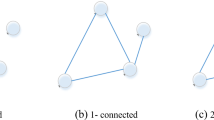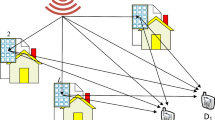Abstract
The ultraviolet (UV) scattering communication can be applied in military networked on-the-move and unattended ground sensor networks. This paper focuses on the connectivity properties of unmanned aerial vehicles (UAVs) network based on UV communication that ensures the secret communications between UAVs. UAVs network is consisting of a group of UAVs, each of which moving according to a particular mobility model. We discuss random waypoint (RWP) mobility model and circle movement based model (CMBM), which can describe the actual movement of UAVs, respectively. In this paper, the approximations of the probability that the network is k-connected are provided with consideration of transmission using on–off keying and pulse position modulation. More precisely, we evaluate the effects of node density, transmission power, and data rate on k-connectivity. The numerical examples show that the mobility degrades the connectivity probability. When the numbers of nodes \(n=500\) and data rate \(R_b =10\,\hbox {kbps}\), the required transmission power for nodes moving according to RWP is lower than CMBM in order to achieve 2-connectivity of the UAVs network, but it is about twice that for uniformly distributed nodes.











Similar content being viewed by others
References
Park, C., Cho, N., Lee, K., et al.: Formation flight of multiple UAVs via onboard sensor information sharing. Sensors 15(7), 17397 (2015)
Xie, J., Wan, Y., Kim, J.H., et al.: Analysis of Mobility Models for Airborne Networks[C] Military Communications Conference, Milcom, IEEE, pp. 858–863 (2013)
Bouachir, O., Abrassart, A., Garcia, F., et al.: A Mobility Model for UAV Ad Hoc Network[C] International Conference on Unmanned Aircraft Systems, IEEE, pp. 383–388 (2014)
Zhao, T., Gao, Y., Zhang, Y.: An area coverage algorithm for non-line-of-sight ultraviolet communication network. Photonic Netw. Commun. 32, 1–12 (2016)
Wang, L., Li, Y., Xu, Z.: On connectivity of wireless ultraviolet networks. J. Opt. Soc. Am. A Opt. Image Sci. Vis. 28(10), 1970–8 (2011)
Vavoulas, A., Sandalidis, H., Varoutas, D.: Connectivity issues for ultraviolet UV-C networks. IEEE/OSA J. Opt. Commun. Netw. 3(3), 199–205 (2011)
Lassila, P., Hyytiä, E., Koskinen, H.: Connectivity Properties of Random Waypoint Mobility Model for Ad Hoc Networks Challenges in Ad Hoc Networking, pp. 159–168. Springer, New York (2006)
Bettstetter, C.: On the connectivity of wireless multihop networks with homogeneous and inhomogeneous range assignment. In: Vehicular Technology Conference, 2002. Proceedings of Vtc 2002-Fall. IEEE, vol. 3, pp. 1706–1710 (2002)
Wang, W., Guan, X., Wang, B., et al.: A novel mobility model based on semi-random circular movement in mobile ad hoc networks. Inf. Sci. 180(3), 399–413 (2010)
Chen, G., Abougalala, F., Xu, Z., et al.: Experimental evaluation of LED-based solar blind NLOS communication links. Opt. Express 16(19), 15059–68 (2008)
He, Q., Sadler, BM., Xu, Z.: Modulation and coding tradeoffs for non-line-of-sight ultraviolet communications. In: Proceedings of SPIE—The International Society for Optical Engineering, vol. 7464, pp. 74640H–74640H-12 (2009)
Hyytiä, E., Lassila, P., Virtamo, J.: Spatial node distribution of the random waypoint mobility model with application. http://www.netlab.tkk.fi/julkaisut/bib/ (Mar 2005)
Wei, W., Wangdong, C., Beizhan, W., Yongjun, L., Guangli, T.: Research on a mobility model based on circle movement in ad hoc network. J. Comput. Res. Dev. 44(6), 932–938 (2007)
Bettstetter, C.: On the connectivity of ad hoc networks. Comput. J. 47(4), 432–447 (2004). (16)
Acknowledgements
This work was supported by Natural Science Foundation of China-Civil Aviation Administration of China Joint Research Fund (No. U1433110), Xi’an beilin science and technology plan projects (No. GX1617), the Shannxi Key Laboratory of Complex System Control and Intelligent Information Processing (No.2016CP05), Scientific Research Program Funded by Shaanxi Provincial Education Department (Program No. 17-JF024) and Fund of Robot Technology Used for Special Environment Key Laboratory of Sichuan Province. We also would like to thank the anonymous reviewers for their comprehensive reviews and comprehensive feedback.
Author information
Authors and Affiliations
Corresponding author
Rights and permissions
About this article
Cite this article
Zhao, T., Xie, Y. & Zhang, Y. Connectivity properties for UAVs networks in wireless ultraviolet communication. Photon Netw Commun 35, 316–324 (2018). https://doi.org/10.1007/s11107-017-0753-5
Received:
Accepted:
Published:
Issue Date:
DOI: https://doi.org/10.1007/s11107-017-0753-5




